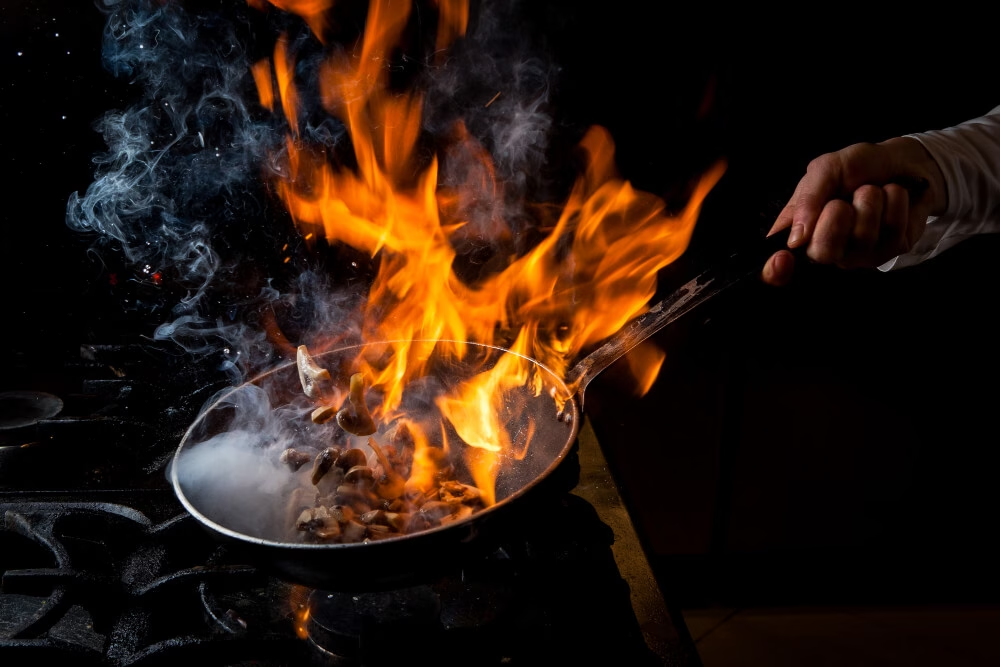Protein fires are among the most difficult types of kitchen fires to clean up. Unlike traditional grease fires, protein fires don’t leave behind thick soot or obvious flames. Instead, they create an invisible, sticky, foul-smelling residue that clings to every surface in your kitchen. If you’ve recently experienced this in your home or commercial kitchen, this guide will walk you through what you need to know — and what to do next.
What Is a Protein Fire?
Protein fires occur when meat (chicken, beef, pork, fish, etc.) or other high-protein food burns, usually due to being left on the stove too long. These fires don’t always look intense, but they release microscopic vaporized proteins and oils that form an almost invisible film over walls, cabinets, and ceilings — along with an unmistakably strong odor.
Why Is It So Hard to Clean?
The residue from a protein fire isn’t like normal soot. It’s:
Nearly invisible
Extremely sticky
Resistant to standard household cleaners
Odorous and difficult to neutralize
Cleaning improperly can worsen the problem, embedding the smell deeper or damaging surfaces.
DIY Steps to Remove Cooking Grease After a Protein Fire
If the damage is minor and confined to a small area, you may attempt a do-it-yourself approach using the following steps:
Step 1: Ventilate the Area
Open all windows and doors.
Use exhaust fans to remove lingering smoke and smells.
Step 2: Wear Protective Gear
Use gloves, goggles, and a mask.
Protein fire residue can irritate your skin and respiratory system.
Step 3: Dry Wipe First
Use a dry microfiber cloth to wipe away the invisible film.
Avoid using water initially — it can spread the residue.
Step 4: Degrease With the Right Cleaners
Use alkaline-based degreasers or enzyme cleaners (not just soap).
Do a spot test to avoid damage to painted or wood surfaces.
Step 5: Wash Soft Surfaces Separately
Curtains, cushions, or clothing must be washed in enzyme detergent or professionally cleaned.
Step 6: Use Odor Neutralizers
Use baking soda, vinegar bowls, activated charcoal, or specialized smoke odor removers.
Air purifiers with HEPA and charcoal filters are helpful for long-term odor removal.
When to Call in Professionals
While DIY methods can handle very light damage, protein fires usually require professional intervention. Here’s when to call experts like Advanced Restoration & Construction in Los Angeles:
The smell persists even after cleaning.
Sticky film remains on cabinets, walls, or appliances.
HVAC systems were running during the fire (contamination risk).
You see yellowing or damage on painted surfaces.
Our professional restoration team uses commercial-grade enzyme cleaners, thermal fogging, ozone treatment, and full-structure deodorization to ensure your property is safe, clean, and odor-free.
Los Angeles-Specific Considerations
Living in Los Angeles means cooking fires are unfortunately common, especially in apartment complexes and older homes with aging electrical systems or ventilation issues. If you’re renting, always notify your landlord immediately. If you own your home or commercial kitchen, take action quickly — even small fires can lead to expensive long-term smoke damage.
Preventing Protein Fires
Here are a few tips to avoid future protein fires in your kitchen:
Never leave meat cooking unattended.
Use timers and smoke detectors.
Clean grease buildup regularly from stoves and range hoods.
Invest in a fire extinguisher and learn how to use it.
Faqs
No. Bleach is not effective against protein residue and may cause discoloration or damage.
If untreated, the odor can linger indefinitely. Professional deodorization is often required.
If the smell and residue remain, it’s best to avoid using the kitchen until proper cleaning is done.
Immediately. The longer residue sits, the harder it becomes to clean and the more damage it can cause.

